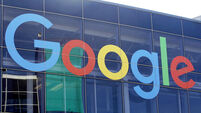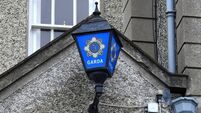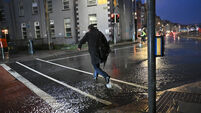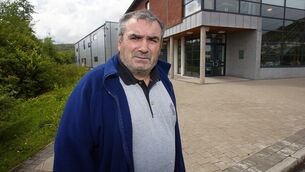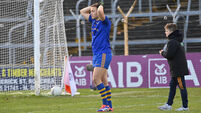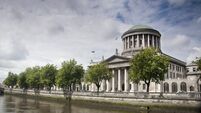Dublin Horse Show: Judges are black and white in choice for best dressed lady
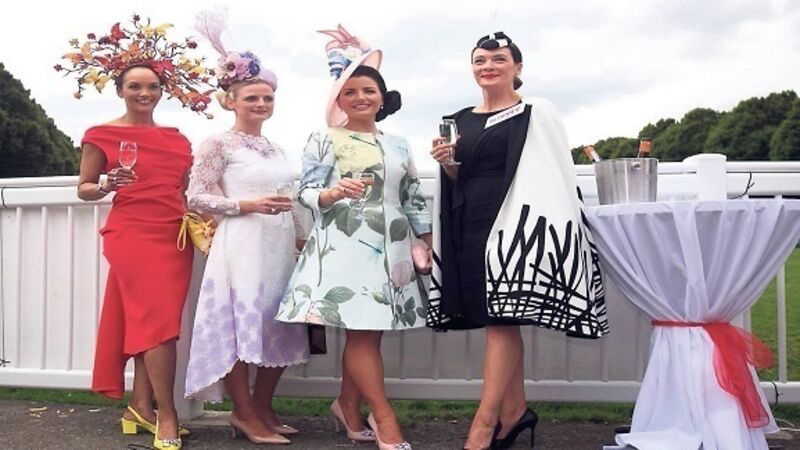
Laura Jayne from Maynooth, Co Kildare, was wearing one of her own designs and had come to the show with her sister, Lisa, who is home from Australia for a couple of weeks.
“I had not seen Lisa for a year and a half and it was her birthday. I wanted us to do something a little bit different together so we decided to spend time at the show.

“I did not intend to enter the competition and, anyway, we were a little late when we arrived and I was sure that registration had closed.
“But because of the numbers entering, the registration process had been kept open for an extra hour. So lucky me!”

Laura Jayne has been in the fashion business for about three years and her stunning black dress was one of her first creations. The cape was from her last collection.
The designer nearly got her outfit destroyed on the way into the show – the sisters walked through an area where horses were being cleaned and just missed being splashed by dirty water.

The top prize was a voucher worth €10,000 for Dundrum Town Centre in Dublin and Laura Jayne will be spending some of it on a surprise gift for her sister.
Another outfit by Laura Jayne featured highly at the Galway Races last month when milliner Mary White from Claremorris, Co Mayo, won the best Irish design prize.
Sarah Cass from Kilkenny was declared the most elegant lady in the competition, that attracted 552 entries.

The Best Dressed Man was Cormac Bates from Wexford.
The Great Lengths Most Creative Hat was won by Linda Morrison from Kilkenny for her outstanding head-piece by Kerry milliner Carol Kennelly.
And it was not the only Carol Kennelly hat worn on the day — 25 women who entered the competition were wearing her hats.
Meath woman, Linda Malone, won the Most Colourful Outfit category with her show-stopping dress from Vanilla Boutique in Fermoy, Co Cork.
The oldest entrant was Philomena Cribbin, 80, from Straffon, Co Kildare, who looked very elegant in her pink outfit.
The most popular colours on the day were white, nude and cream and the most popular themes were vintage and floral.
Long faces
Horses share surprisingly similar facial expressions to humans and chimps, according to researchers.
Like humans, horses use muscles underlying their nostrils, lips and eyes to alter their facial expressions in a variety of situations, researchers found.
The findings, published in the journal PLOS ONE, suggest evolutionary links in different species in how the face is used for communication.
The Equine Facial Action Coding System (EquiFACS), which was devised by a University of Sussex team along with researchers at the University of Portsmouth and Duquesne University in Pittsburgh, identified 17 discrete facial movements in horses, compared with 27 in humans, 13 in chimps and 16 in dogs.
The study’s co-lead author, doctoral researcher Jennifer Wathan, said: “Horses are predominantly visual animals, with eyesight that’s better than domestic cats and dogs, yet their use of facial expressions has been largely overlooked.
“What surprised us was the rich repertoire of complex facial movements in horses, and how many of them are similar to humans.
“Despite the differences in face structure between horses and humans, we were able to identify some similar expressions in relation to movements of the lips and eyes. What we’ll now be looking at is how these expressions relate to emotional states.”
Co-lead author Prof Karen McComb said: “It was previously thought that, in terms of other species, the further away an animal was from humans, the more rudimentary their use of facial expressions would be.
“Through the development of EquiFACS, however, it’s apparent that horses, with their complex and fluid social systems, also have an extensive range of facial movements and share many of these with humans and other animals.
"This contributes to a growing body of evidence suggesting that social factors have had a significant influence on the evolution of facial expression.”
She added that the findings should ultimately provide important information for veterinary and animal welfare practices.






